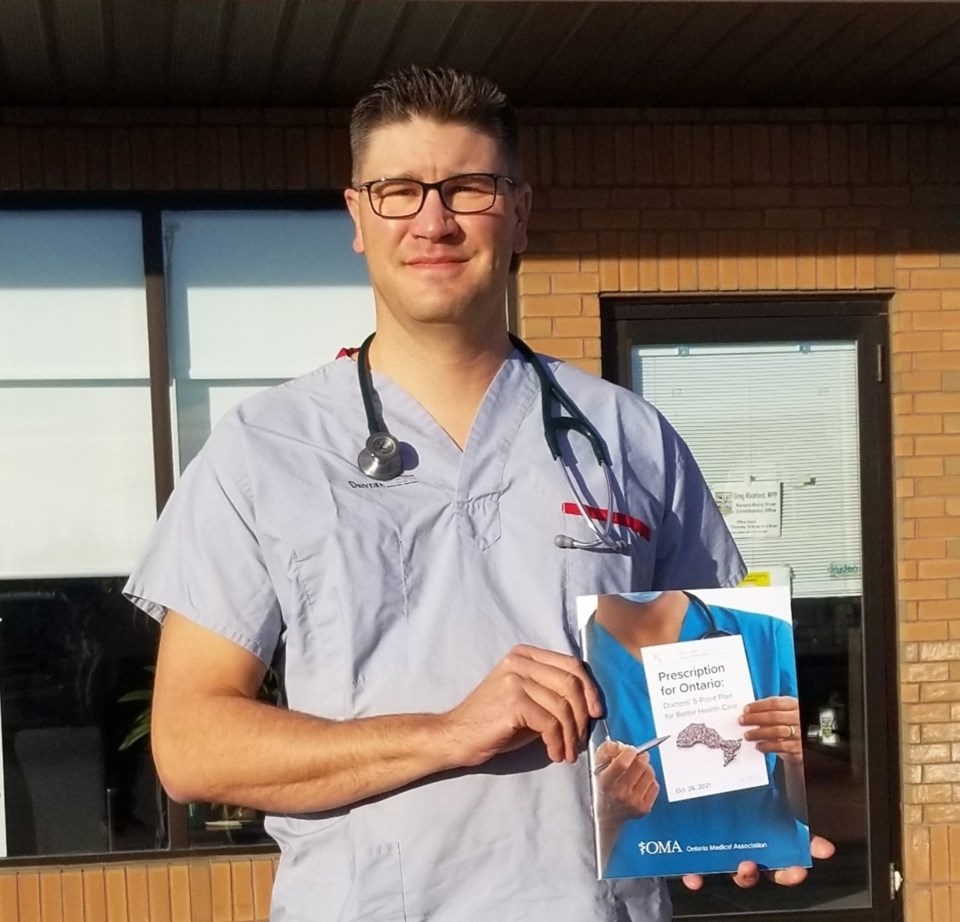Dryden family physician Dr. Stephen Viherjoki says a long term solution to the doctor shortage in the North involves finding more people like him.
Viherjoki, the chair of the northwest district for the Ontario Medical Association, said his connection to the area runs deep having grown up in Thunder Bay having his family come from the Northwest.
“I have never wanted to leave the region,” he said. “I am an avid hunter and fisherman.”
He said the group practice in Dryden appealed to him when he was looking for work 15 years ago and he wanted to raise his family in the community, which he described as safe and welcoming with beautiful surroundings.
“Even my first home in Dryden, I was overlooking the lake. It's really the place I want to be,” he said. “I really feel privileged to be able to work here and I wouldn't change it if I could.”
Viherjoki said as a rural doctor, the breadth of practice is very wide. Along with his practice, he also serves as chief of the emergency services at the Dryden Regional Health Centre and as the regional chief medical information officer for the Thunder Bay Regional Health Science Centre.
Viherjoki gave a presentation with his counterpart for the Northeast district, Dr. Stephen Cooper, at the provincial pre-budget consultation hearing in Sault Ste. Marie last week.
They presented suggestions which could immediately address the shortage of doctors, long wait times and pressures on hospitals. For a longer-term solution, Viherjoki said the key to retaining doctors is training or finding ones who have connections to the region.
“We've learned in the past, for instance when I was first coming into the region [15 years ago], there were a lot of a previous generation of international medical graduates here,” he said.
“They came for large signing bonuses and confirmation of their license, meaning if they worked in an underserviced area for two years, they were basically granted an unrestricted Canadian license or Ontario license and they could work where they wanted. Their obligation was over.”
Viherjoki said the people who came were excellent doctors, but they really had no connection to the community and came from places where there was no local community for them.
“We've learned from experience that people who grew up in the region or who have other strong ties such as spouses or close family or they have a family cabin here, people who have a strong love of outdoors, so fishing or hunting or those types of things they tend to do better,” he said.
"Pure signing bonuses don't work, he said.
“Money gets people in the door, but it does not get people to stay,” he said.
Viherjoki said an aging physician workforce makes the situation worse.
“Compared to June 2021, our need for family physicians has gone up like 10 per cent,” he said. “Even with [the Northern Ontario School of Medicine graduating doctors] and those students staying in the region, we're still worse off than we were before.”
Viherjoki said nothing is surprising about the situation and the consequences were expected considering the policies from the 1990s which froze and reduced medical school enrolments, and that physicians who are baby boomers are retiring.
“Until we get anywhere near supply equaling demand,” he said. “Until we get those 200 family physicians in the north, [and] 110 rural generalists, which is what we need right now, there's no way that people aren't going to feel under water.”
Viherjoki said what’s needed are more medical school spots, including at NOSM, and nurturing the next generation of doctors by getting students interested at an earlier age.
He said communities also need to create good experiences to the entire family and not just the doctor.
“You have to find meaningful work for spouses and good education and safe places for their children,” he said. “So, if you get a physician to come but their spouse is miserable, they're not going to stay.”
He also said doing exit interviews with doctors who leave the area is also really important to find out what’s not working.
“We've been trying to do those over the years here in Dryden,” he said. “I think that a lot of the situations people are going into are already unstable.”
Viherjoki used Rainy River as an example.
“Rainy River has an allotment of two physicians I think, which means at the end of the day, someone is on call 50 per cent of their life. If one person gets sick, now you're in a situation where you're basically on call 100 per cent of the time. That is completely unstable,” he said. “If you want to live with your family and see your kids grow up or be able to have a vacation, you can't be available 24/7 much more than once a week.”
He said the expectation of a rural physician to be available to their whole practice all the time is not realistic and probably not in anyone's best interest, which is why having more doctors is needed.
And the challenge for rural communities in Southern Ontario is still not the same as in the North, he said.
“The differences in those communities, your neighbouring hospital might only be 30 minutes or 40 minutes away or might be right next door and [there are] walk-in clinics available just about everywhere,” he said.
“If you live in Dryden, there's nothing available. You're either in the emergency room or you're in an emergency room in a different town because there [are] no walk-ins outside of Thunder Bay and Thunder Bay is swamped.”
